![]()
Marion Co TOC
Homepage
What's New?
Awards
Cemeteries
Census Records
Courthouse Info
Family Genealogies
Heritage Society
Society's Newsletters
History + more
Marion History-book
Maps
Marion Co Timeline
Marriages
Mt Meadow Massacre
Newspapers
Obits
Photo Gallery
Post Office History
Queries
Resources
Reunions
Townships
Transcribed Records
Trip to Yellville?
Helpful Links
Contact -
Jeana
Graphics by Rhio

Laffoon Cemetery
Cabin Creek & Buffalo River
Marion Co, AR
By: Gary Farley
Submitted By:Clarissa Farley
![]()
Less than two miles below the mouth of Rush Creek, just past the mouth of Cabin Creek, between mile 131 and 132, hidden from those floating down the Buffalo River is an old cemetery. Only 20 of its estimated 70 graves are marked by "store bought," engraved stones. Many of these stones bear the family name of Laffoon. Most of the persons known to be buried there, as will be discussed later in this article, are connected by kinship ties, regardless of their surname. The cemetery is on a high bench with deep soil, one of the few spots suitable for burial.
A century or so ago a wagon road ran nearby this cemetery. Loads of ore from the zinc mines in Rush creaked along on the way to Buffalo City for shipment down the White River or on the railroad. Today the cemetery is grown up. Access is difficult. It is a rare remnant, a reminder of more than a century of human settlement along the lower Buffalo.
The land occupied by the cemetery was entered at the land office by Thomas M. Laffoon in 1883. His body is buried in the graveyard. The stone with the earliest engraved date of death there honors his father, Flavius Terry Laffoon, who died in 1878 at age 45. Land to the east of the cemetery belonged to Flavius and his wife Judia. However, it was not entered until 1885. Unconnected, a little to the west were two additional 40 acre tracts entered by an older brother of Flavius, James M. Laffoon.
James was mentioned casually in an early report from 1853 related to the village of Buffalo City. He clerked in a store there. Apparently, two stores had been established on the White, near the mouth of the Buffalo a few years before. Their purpose was to serve the growing settlements along these two rivers. James also had a 40 acre entry at the mouth of Laffoon Creek which flows into the White River at Buffalo City. (It is probable that the creek was named for James.) These tracts were entered in 1855 and 1860. Lycargus Laffoon, another brother of Flavius, had entered a 40 acre tract in that area in 1861. (Since the earliest burial in the cemetery pre-dates the entry of the land by Thomas, I wonder if members of the Laffoon family had not squatted on this river bottom land, raised crops, trapped animals for the pelts and finally purchased the land.)
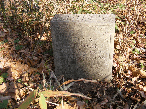 Life for Judia, left a widow of Flavius at the age of 40 with six of her seven children still minors, must have been difficult. Due to the fact that the land records in Yellville, the county seat of Marion, were burned on several occasions, there is no way to determine the extent of the land holdings of the Laffoon family along this portion of the Buffalo in the early days.
Life for Judia, left a widow of Flavius at the age of 40 with six of her seven children still minors, must have been difficult. Due to the fact that the land records in Yellville, the county seat of Marion, were burned on several occasions, there is no way to determine the extent of the land holdings of the Laffoon family along this portion of the Buffalo in the early days.
How did the Laffoon family come to settle along the Buffalo River? These three brothers-James, Flavius and Lycargus, their mother Elizabeth, and several siblings, as well as the family of an aunt and uncle by the name of Samford, had moved from Middle Tennessee ca 1845 to Arkansas. Their father Matthew Laffoon drops from the records between 1845 and the 1850 census. The family line extends back to France and the Huguenots. Ancestors served in the Revolutionary War army from the state of Virginia. Following independence portions of the Laffoon line moved to Kentucky. In the 1830s some of this family moved to Tennessee and then to Arkansas. Others moved to western Missouri.
By the 1850 census James, age 35 had settled in Marion County. He had a wife and children. His mother and the rest of this Laffoon family were located in Jefferson Township of Carroll County, Arkansas, now a part of Boone County. In all, I have a list of 19 children born to Elizabeth Samford Laffoon and her husband, Matthew the parental couple. Further, the Samford family came with them. Matthew is not listed in the 1850 census for Carroll County, so I am assuming that he had died, perhaps on the journey. The children living with mother Elizabeth in 1850 included Thomas, Elizabeth, Mary, Flavius T, Edward, Lycargus, Gideon, Cecastius, Evaline, and Matthew. Matthew was only five and had been born in Arkansas. Living at the next stop for the census taker was William, the second son of Elizabeth and Matthew, age 32, with a wife and children. Elsewhere in Carroll, now Boone, was another son, Richard. (He will be found in the 1880 census for Marion County, Arkansas.) Top of Page
During the 1850s several of the Laffoons moved from Carroll County to the Buffalo River and Marion County. Also, some Laffoons appear to have been a part of the Fancher wagon train made famous by the Mountain Meadows Massacre in Utah in 1857. In comparing the 1850 and 1860 censuses for Carroll and Marion several possible persons appear, but more research would be needed to identify just which one, or ones, may have been among those who died on the way to California. (The lists of victims includes an unspecific reference to a Laffoon family.) And like many other Arkansas families, some of the Laffoons moved on west to Oklahoma and California in later generations.
James continued to live on the Buffalo in the 1860 census with a family. His death is listed as being in 1864 in the family records. His brother William had died in 1861. One wonders if either death was connected to the Civil War hostilities.
Elizabeth and the younger children had moved over on the Buffalo also. The census indicates that they were neighbors of James and his family. The older sons, Thomas, William, Flavius, and Lycargus, were found in Carroll by the 1860 census. Also the Samford kin and the Nicholas Thomas family, which had become kin to the Laffoons in 1854 when their daughter Judia married Flavius, are listed.
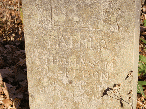
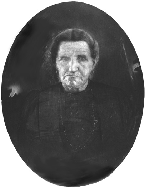 Family tradition holds that Judia Thomas Laffoon was of Cherokee Indian blood. Data listed in the census records allow for this. The tombstone lists her birth as being in 1837. In the census records Judia lists Missouri as her place of birth. Her father, Nicholas Thomas, is listed as being born in 1799 in Missouri and her mother, Manda, as being born in South Carolina in 1809. There were very few Europeans in Missouri in 1799 and there were many Indians in South Carolina in 1809. (In the 1880 census Nicholas and Manda were living with Judia on the Buffalo. So, it is very possible that they are buried in a grave with no formal stone marking in the Laffoon Cemetery.) From the 1860 Carroll County census one learns that the Thomas family had come from Missouri to Arkansas in 1841. Five siblings of Judia are present in the family-Andrew Jackson, Dianny, James, Jasper and Mary Ann-ages 6 to 19. If the Thomas' were Native Americas, it seems ironic to me that a son, born during the period of the Trail of Tears, would have been named for Andrew Jackson. The large oval picture of Judia from the early 20th Century, which we have, suggests both that life had been hard and that she may well be of Native American heritage. Top of Page
Family tradition holds that Judia Thomas Laffoon was of Cherokee Indian blood. Data listed in the census records allow for this. The tombstone lists her birth as being in 1837. In the census records Judia lists Missouri as her place of birth. Her father, Nicholas Thomas, is listed as being born in 1799 in Missouri and her mother, Manda, as being born in South Carolina in 1809. There were very few Europeans in Missouri in 1799 and there were many Indians in South Carolina in 1809. (In the 1880 census Nicholas and Manda were living with Judia on the Buffalo. So, it is very possible that they are buried in a grave with no formal stone marking in the Laffoon Cemetery.) From the 1860 Carroll County census one learns that the Thomas family had come from Missouri to Arkansas in 1841. Five siblings of Judia are present in the family-Andrew Jackson, Dianny, James, Jasper and Mary Ann-ages 6 to 19. If the Thomas' were Native Americas, it seems ironic to me that a son, born during the period of the Trail of Tears, would have been named for Andrew Jackson. The large oval picture of Judia from the early 20th Century, which we have, suggests both that life had been hard and that she may well be of Native American heritage. Top of Page
Flavius and Judia had seven children, several of whom-Thomas, William Preston , and John F.-- are among those whose burial is marked in the Laffoon Cemetery. And it is possible that other Laffoons are buried there also in the graves without stones. And given the nearness and accessibility of this cemetery to Rush, some of the miners and others who died there may be among those buried in this graveyard in unmarked graves.
During the Civil War Flavius served in the Confederate Army. He joined in the summer of 1862 in Izard County. The unit is listed as the 27th Division of Arkansas Infantry. At the time that he entered the army, he left three small boys at home with Judia. As the marker in the Laffoon cemetery declares, Judia lived through this into her nineties, dying in 1929.
Given the data now in hand, this seems to be the picture of the settlement of the Laffoon family in this region. They came from middle Tennessee ca 1845 with most of them settling near what is now Harrison. The oldest son settled in Buffalo City in Marion County. Many members of the family move in the late 1850s and through the 1860s over on the Buffalo River around where the Cabin and Cedar Creeks flow into the river. They farmed the river bottoms. They attended school and church with their neighbors. The development of zinc mines in near by Rush from 1880 through 1920 brought many changes. Many of the men found seasonable employment in the timber industry. Stores were more accessible with the development of Rush. Yet, the families lived off the land for the most part..
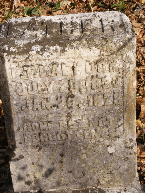 Now, let's return to our account of the cemetery. The second marked grave in the cemetery is that of the son of Judia and Flavius, John F. He was only 21 when he died in 1881. Was there an accident in the woods, or on the river?
Now, let's return to our account of the cemetery. The second marked grave in the cemetery is that of the son of Judia and Flavius, John F. He was only 21 when he died in 1881. Was there an accident in the woods, or on the river?
The census of the year before had listed him along with brothers William, Andrew and James and sisters Manda and Dorah (or Mary Jane). Brother Thomas was married with two daughters, and living as a near neighbor. (He also had a son.) The third and fourth stones are for Mary Laffoon, the first wife of Thomas (son of Flavius and Judia) and for an infant child of Thomas and Mary. Both died on March 6, 1883. Death in childbirth was not unusual then. Thomas was left with three small children. He did not remarry until about a decade later.
Uncle Richard Laffoon and his family were the next stop for the census taker in 1880. The next stop was at the home of an Aunt Elizabeth, the widow of an unknown Laffoon, perhaps Preston, a brother of Richard. Four children and three boarders rounded out that household. Two are young men. One is a servant girl.
The next stone commemorates the death of an infant of Andrew Jackson Laffoon (son of Flavius and Judia) and his wife, Dora Ann Brantley. The child died in 1894. The Brantleys are another major family in the area. Lou Ann Ott who has written two books on Rush descends from the Brantleys. There is a small Brantley graveyard in the wilderness area across the Buffalo River.
The sixth stone is for Andrew Pettit who died in 1896 at the age of 50. His wife, Lucindia Pettit, died the following year. She is identified on her stone, the seventh, as a mother and was 43 years old. In the 1900 census three minor Pettit boys are listed in the home of Thomas Laffoon. A guess would be that they were nephews, the children of Lucindia, who might have been the sister of Thomas' wife, Prilda Maxey, but this needs to be looked into more. The Maxeys were a major family in the community. (Bill and Mindy Maxey were the last family in Rush, I understand.) Top of Page
Next is the stone for a two year old child named Eliza Elmiry Laffoon. It is a nice stone. Her parents were Thomas and Prilda Laffoon. There is a family story that she was a very bright child. Her father never fully recovered from her death, I am told.
Joe Wheeler, a child of only four, died in 1904. The Thomas and Ellen Wheeler family was living among the Laffoons in the 1900 census. Surely, Joe was their child. Another Wheeler child, Alta, died in 1916 at age 2. Three Pattersons died in 1905. C.S. and Mary appear to have been husband and wife. Mary was an older child who was married to J. H. Martin. Neither of these families is listed in the 1900 census for Buffalo township. There is another Martin grave with no date. It is marked by one of those metal markers, still in good shape, that are placed in a cemetery prior to the placement of a stone. The name is Floyd E. Martin. The Pattersons were connected with the Maxey family which lived nearby. And Prilda Maxey was married to Thomas M. Laffoon. The Pattersons were also connected with the Laffoons through the children of Edward Laffoon, a son of the older Matthew and Elizabeth. The same is true of the Wheelers.
William Preston Laffoon, son of Flavius and Judia, died in 1914. He was 53. He was married to Cynthia Wood. She died in 1940 and her stone is the last marked grave in the cemetery.Among the unmarked graves in the cemetery are seven infants of William Preston and Cynthia.
Son, Thomas Laffoon died in 1933. It was his land where the cemetery lay. His son George continued to farm and look after the Laffoon land along the river until it was purchased by the NPS. He has two daughters still living in the Cozahome area. I am hopeful that they will be able to add more information to this brief history. It will be included in a future revision.
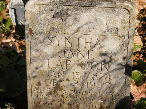 The other three marked graves date from 1919 and probably are related to the great influenza epidemic of that time. James Smith was the son of Judia's youngest daughter, Mary Jane, and her husband Jesse Dewitt Smith. The Smiths have been traced back to Hamilton County, Tennessee. The 1860 census of Searcy County, Arkansas, Tomahawk Township, finds Jess and Nancy Smith, now in the 70s, along with several married sons and their families. Among these was Thomas and Elizabeth Smith and their son William Lenard Smith. Early in the Civil War, Len, as he was called, was conscripted into the Confederate Army. Before long he deserted and joined the Union Army. Len married Ellen Harbert while on duty in Missouri. Among their children was Jesse Dewitt Smith, the father of James Ray Smith who is commemorated by the stone we are now considering. (Later Len married a Dillard, one of several Smith-Dillard connections.)
The other three marked graves date from 1919 and probably are related to the great influenza epidemic of that time. James Smith was the son of Judia's youngest daughter, Mary Jane, and her husband Jesse Dewitt Smith. The Smiths have been traced back to Hamilton County, Tennessee. The 1860 census of Searcy County, Arkansas, Tomahawk Township, finds Jess and Nancy Smith, now in the 70s, along with several married sons and their families. Among these was Thomas and Elizabeth Smith and their son William Lenard Smith. Early in the Civil War, Len, as he was called, was conscripted into the Confederate Army. Before long he deserted and joined the Union Army. Len married Ellen Harbert while on duty in Missouri. Among their children was Jesse Dewitt Smith, the father of James Ray Smith who is commemorated by the stone we are now considering. (Later Len married a Dillard, one of several Smith-Dillard connections.)
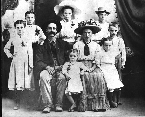 In the 1900 census Jesse and Mary Jane (Dolly) Laffoon Smith were living among the Laffoons on the Buffalo. (The Smiths are buried at the Desoto Cemetery.) Over the next two decades they would have 12 children. Some of these are buried at Desoto. Many of the children lived along the Buffalo and worked in Rush in the boom days. Jesse Dewitt and Mary Jane Smith had a large family. Among the family stories is one about them living in tents on Clabber Creek in the 1920s. They also went by wagon to pick cotton down on the Arkansas River and drove cattle over the Boston Mountains.
In the 1900 census Jesse and Mary Jane (Dolly) Laffoon Smith were living among the Laffoons on the Buffalo. (The Smiths are buried at the Desoto Cemetery.) Over the next two decades they would have 12 children. Some of these are buried at Desoto. Many of the children lived along the Buffalo and worked in Rush in the boom days. Jesse Dewitt and Mary Jane Smith had a large family. Among the family stories is one about them living in tents on Clabber Creek in the 1920s. They also went by wagon to pick cotton down on the Arkansas River and drove cattle over the Boston Mountains.
The young daughter of J. H. And Ethel Nichol also died early in 1919 at age 3. The final marked grave is that of E. J. Friend. He was 63 when he died in 1919. I do not know of any connection with the Laffoons. This leaves 30, 40, or more about which there is no information.
According to family tradition, the final burial in the cemetery was for a man named Charles Cole. His casket was constructed on the porch of the old store in Rush, the one across the road from the Morning Star mine. Unmarked, his grave was near the old gate.
In 1987 when the National Park Service purchased the land that Judia and her heirs had owned on the Buffalo for over a century, more than 200 descendants were directly involved. Today, some still own other lands in Marion County. Some still live nearby. Top of Page
This past Fall several of these descendants got together at Buffalo Point. The Park Service employees were very helpful and hospitable. This set of descendants found access to the Laffoon Cemetery very difficult. They would like to be able to have reasonable access to this place. They applaud the wonderful work that is being done at Rush. They would like to see just a little bit of attention given to this other historical settlement site in the area. Perhaps just a low water crossing on the road down Cedar Creek. And perhaps a path or trail along the old ore road back to the cemetery.
In reflecting upon the settlement of the Buffalo River Valley, I am reminded of the two visions which typically drove the settlement of the American West, particularly in the mountainous areas. One was that of those who sought to find a place to live well off of the land. Some have called them "nesters". Often their vision is labeled the "Jeffersonian" dream. The other was those who sought to strike it rich and then move on. Often they have been labeled the "boomers". The settlement around Cabin and Cedar Creek, like that at Boxley, was an example of the former. Rush was an example of the latter.
Most of the tellers of our history have sung of the exploiters, the boomers, the "strike it rich and move on" persons. Often there were colorful and exciting stories that could be told about them. More common were the folks like the Laffoons, the Brantleys, the Maxeys and their neighbors who were driven by another dream. Changes in the economy made their dream obsolete, it seemed.
I am saddened that neither dream seems to live on, except that there is a new generation of settlers on the ridges back from the Buffalo who seem more interested in the lifestyle of the Laffoons than that of the miners. Of course, among them are those who, like the miners, are seeking to exploit their environment for short term rewards.
There are lessons to be learned from the Boxleys and the Cedar Creeks as well as from the Rushes. I hope that both are presented. I hope that this article will be a "living" document. I hope that others will share stories, obituaries, pictures and other data related to the persons buried in the Laffoon Cemetery. These will be added to the document increasing our knowledge of and appreciation for those who lived in this area.
The End, for now.
Return to Marion Co Home Page
